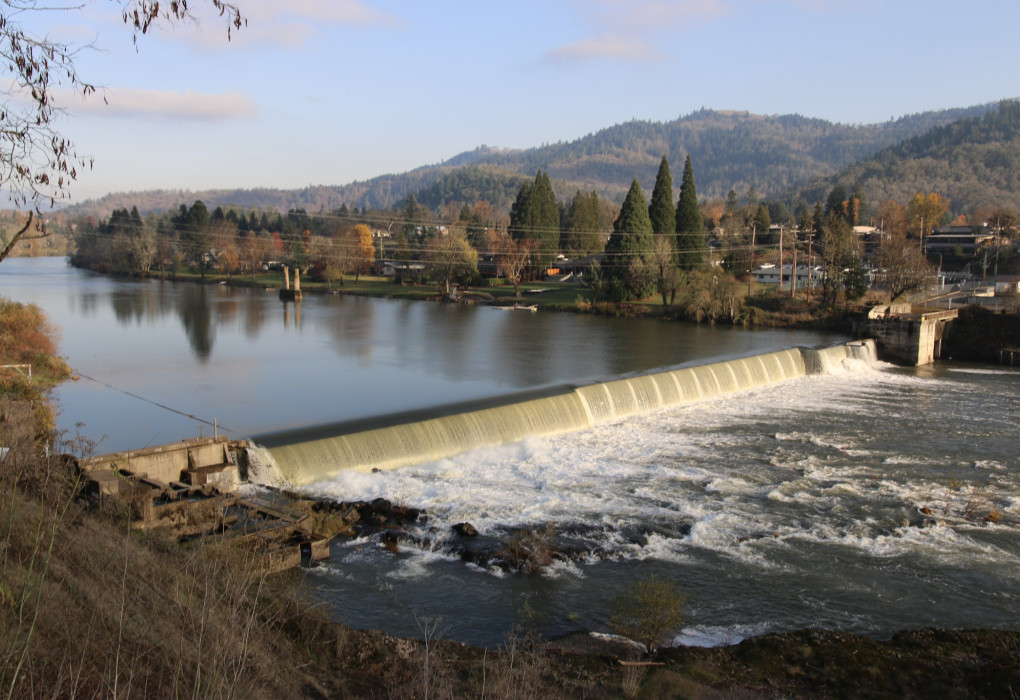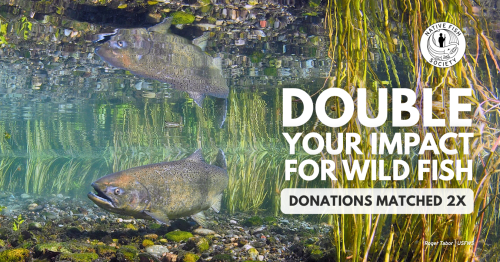Winchester Dam Repairs Begin Despite Permitting Irregularities, Collapsing Summer Steelhead Run, and Fears of Another Fish Kill
2023 Repair at Dam First Since Botched 2018 Attempt Caused Fish Kill and Polluted Drinking Water Supply for 37,000 People
Winchester, OR – On Monday August 7th, the fish ladder at Winchester Dam on the North Umpqua River near Roseburg will close until August 28th to allow reservoir drawdown and structural repairs at the 450-foot wide, 17-foot tall, 130-year-old wood, steel, and concrete structure. This drawdown method, chosen as the cheapest dam repair method by dam owner Winchester Water Control District over other well-established and more fish-friendly dam repair options, will release stored sediment downstream onto state-designated Essential Salmonid Habitat/federally-designated critical Coho salmon habitat while creating a migratory dead-end for imperiled summer steelhead, spring Chinook salmon, and other native species attempting to move upstream to the 160 miles of excellent cold water habitat above the dam. The release of stored water downstream on August 7th will likely attract native migratory fish towards the dam just after the ladder closes, confining them for weeks to the warm water below the dam, with no cold water refugia nearby. Compounding this harm, the reservoir refill occurring around August 28th will temporarily reduce river flows downstream of the dam during the driest and hottest period of the year and likely injure North Umpqua instream water rights intended to protect salmon and steelhead. Adding insult to injury, Oregon Department of Fish and Wildlife (ODFW) officials declined to answer river advocates’ formal request to use their authority to require a less harmful repair alternative maintaining upstream fish migration – only weeks before collapsing summer steelhead numbers spurred ODFW to shut all angling in the North Umpqua from August through November.
Winchester Dam is a derelict former hydropower facility now owned and maintained solely to provide a private water ski lake for approximately 110 landowners surrounding the reservoir pool. River advocates from a coalition of fishing, conservation, and whitewater groups have been working for years to raise alarm bells with government officials over the Winchester Water Control District’s chronic non-compliance with state and federal repair permitting, engineering, water quality, and dam safety requirements as well as their disregard for protections for fish and wildlife despite the essential habitat importance of the North Umpqua for salmon and steelhead.
Concerns and irregularities that river advocates raised during the permitting process in the lead up to the 2023 repairs include but are not limited to:
1. The dam owners failed to disclose to regulators that during past unpermitted repairs, the release of stored reservoir water also released stored sediment downstream onto salmon habitat and into public drinking water supplies. State and federal permit approvals for the 2023 repair were given after the dam owners told regulators that the presence of invasive aquatic plants in the reservoir would prevent the release of sediment and, additionally, that they would secure a 50’ x 100’ tarp to the reservoir bed with sandbags. The plants and tarp will be subject to the full force and flow of the river flowing through the dam’s two narrow water release gates. (On average, Winchester Dam repairs have occurred once every three years since the 1960s, but public records show no permits for repairs prior to 2023.)
2. State records show the dam owners have previously repaired the dam by installing large numbers of toxic pressure-treated wood planks. The U.S. Environmental Protection Agency and U.S. Department of Human Services recommend that treated wood not be used where it may come in direct or indirect contact with public drinking water. Winchester Dam is just 50 feet upstream from Roseburg’s public drinking water intake. Despite this, regulators have not required removal of any pressure-treated wood from the structure. The 2023 repair plan calls for drilling large numbers of holes into the dam’s pressure-treated wood to secure a steel lattice.
3. Previous repairs used rock fill to repair the many cavities within the wooden central span of the dam. As a cost-saving method, the 2023 dam cavity repairs will abandon rock fill in favor of injections of chemical-intensive polyurethane foam, a known source of microplastic pollution, just 50 feet upstream from Roseburg’s public drinking water intake.
4. The Winchester Dam owners were notified by state officials in a January 2023 letter that they were storing water in excess of their filed water rights claim SW 398. The letter instructed the owners to come into compliance by lowering their reservoir pool by 1.5 feet, or to file for a new water right. The owners have disregarded the state’s instructions, and instead proposed a repair involving a reservoir refill that will likely injure downstream water rights, including certificated instream rights intended to protect the North Umpqua’s invaluable fisheries, including Oregon Coast Coho, which are listed under the federal Endangered Species Act. Despite ongoing unlawful storage of water, the dam’s repair proposal has received all necessary state and federal permits.
Harm from the most recent previous Winchester Dam repair is well-documented. According to state investigators, pollution from the 2018 repairs at the dam degraded aquatic habitat, killed fish, and harmed the primary drinking water source for the City of Roseburg and the Umpqua Basin Water Association – serving approximately 37,700 people combined. Investigators also found that dam repairs were conducted without following known best management practices, even after authorities provided the dam owners with information in advance on how to protect water quality and fish. Winchester Dam lies entirely within state-designated Essential Salmonid Habitat and federally designated critical habitat for Oregon Coast Coho salmon protected under the federal Endangered Species Act.
Unfortunately, 2018 likely wasn’t the first time Winchester Dam repairs polluted drinking water supplies and harmed North Umpqua fish and wildlife. Public records describe “leakage” during one previous repair and a state official complaining to the contractor “about cement in the river and no permits.”
According to the Oregon Department of Fish and Wildlife, Winchester Dam impedes access to 160 miles of high-quality habitat for salmon and steelhead. Recently, the coalition forced the owners to finally agree to a schedule for bringing their emergency preparedness into compliance with state law for the first time in decades.
River advocates will be documenting the repairs during the three-week fish migration closure and will be available to reporters for comment.
FOR MORE INFORMATION, PLEASE CONTACT:
Jim McCarthy, WaterWatch of Oregon, 541-941-9450, jim@waterwatch.org
Kirk Blaine, Native Fish Society, 307-299-7834, kirk@nativefishsociety.org

